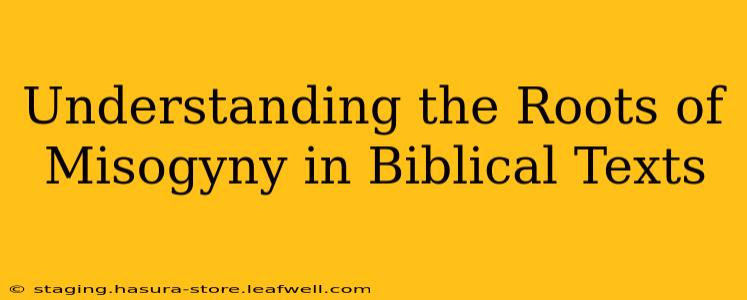The Bible, a collection of texts revered by billions, has been both a source of comfort and a subject of intense scrutiny. One particularly contentious area of debate centers around the perceived misogyny present within its pages. This isn't about condemning the entire text, but rather understanding how certain passages have been interpreted to justify patriarchal structures and harmful attitudes towards women. This exploration delves into the historical context, varied interpretations, and the ongoing conversation surrounding this complex issue.
What are some common examples of misogyny in the Bible?
This question often arises, and it's crucial to address it with nuance. Pinpointing specific verses as inherently "misogynistic" can be misleading without considering the historical and cultural context. However, certain passages have been cited repeatedly as problematic. These often include stories depicting women as temptresses (Eve in the Garden of Eden), sources of punishment (the downfall of Samson), or lacking agency in their own lives (Sarah's role in the story of Hagar). Furthermore, the exclusion of women from leadership roles in many interpretations and the subjugation described in certain passages (Ephesians 5:22-24, for example) are frequently brought up in discussions of biblical misogyny. It's crucial, though, to remember that interpreting these passages requires careful consideration of their historical context and various theological perspectives.
How has the historical context influenced interpretations of these passages?
Understanding the historical and cultural backdrop of the biblical texts is paramount. Many of these passages were written in societies deeply patriarchal and where women held significantly less power than men. These societal norms undoubtedly influenced the narratives and perspectives presented. The legal and social structures of the time often dictated women's roles and opportunities, which are reflected in some of the biblical accounts. Interpreting these texts solely through a modern lens risks misrepresenting their original intent while ignoring the significant evolution in understanding gender roles and equality that has occurred since their writing.
Are there different interpretations of these passages that challenge the notion of misogyny?
Yes, absolutely. The Bible is a rich and complex text with a multitude of interpretations. Many feminist theologians, for example, argue that focusing solely on the seemingly negative portrayals of women neglects the many strong and influential female figures throughout the biblical narratives (Deborah, Esther, Miriam, to name a few). They highlight the agency some women exercised within their limited social spheres and argue that the texts should be interpreted through a lens of liberation rather than condemnation. Furthermore, some scholars argue that certain passages are misinterpreted due to translation issues and cultural biases that have crept into interpretations over millennia.
How does the Bible portray positive female figures?
While acknowledging the passages that have fueled discussions about misogyny, it is essential to recognize the significant number of positive female figures in the Bible. These women often demonstrate courage, faith, wisdom, and leadership. Figures like Esther, who risked her life to save her people, and Deborah, a judge and prophetess who led Israel in battle, challenge the notion that the Bible solely presents a negative image of women. The narratives surrounding these women offer counterpoints to the more problematic interpretations and showcase the diverse roles and contributions women played throughout biblical history. Understanding both the positive and negative portrayals allows for a more balanced and nuanced understanding of the biblical text and its portrayal of women.
What is the ongoing debate surrounding the interpretation of biblical texts and gender?
The debate surrounding the Bible and gender roles continues to evolve, reflecting ongoing societal shifts in understanding gender equality and power dynamics. Feminist and liberationist theologies actively challenge traditional interpretations that reinforce patriarchal structures. These perspectives seek to reclaim and reinterpret biblical narratives, focusing on empowering women and challenging oppressive readings. Simultaneously, conservative interpretations maintain a more traditional view, emphasizing the authority of scripture and adhering to interpretations that reinforce traditional gender roles. This ongoing discourse highlights the complexity of biblical interpretation and its continuing relevance in contemporary discussions about gender and faith.
Conclusion:
Examining the Bible’s portrayal of women necessitates a deep dive into historical context, diverse interpretations, and ongoing theological debates. While some passages have been used to justify misogynistic views, others present strong and influential female figures. Understanding the complexities of these texts is crucial for responsible and insightful interpretation, fostering a more nuanced and balanced understanding of their place in the ongoing conversation about gender and faith. This journey requires critical thinking, historical awareness, and a willingness to engage with multiple perspectives.

